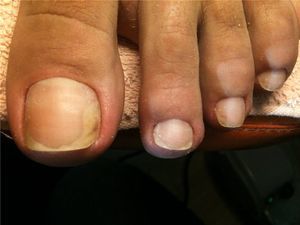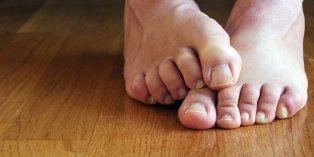Among the common people of a variety of diseases that are not life-threatening, however, to deliver severe discomfort. Onychomycosis is a representative of the fungal disease. It affects the nail plate, completely destroying it. A moist and warm environment is ideal for its propagation. The symptoms of fungal nails are often hidden, and at the end of the condition it is already in liquid form.

The main mycoses
The nails are affected by the various types of mycosis. The most common dermatophytes. The red Trichophyton affect the skin of the hands and feet. The main symptoms — the spots are yellow or white in color shades of light. Gradually the area of infection continues to grow, changing the color of the entire nail, and he begins to move away from the bed. In severe cases, it means that it is a fungus that affects the skin.
Trichophyton Mentagrophytes interdigital starting from the surface, and then moves to the top. It seems to be a yellow or a white spot, which is transformirovalsya in the subungual hyperkeratosis. The disease usually affects just the thumbs or the fingers. Your pathogen actively multiplies in the warm season of the year.
Much less common Trichophyton purple. It is more common in the far East and in Central Asia. The impact on the scalp as well as it is more commonly known as ringworm. If it is left untreated, the nails a dark skin tone.
Fungus under the toenails and it is caused due to the yeast infection fungi. Pathogens — Candida, the white, and Candida parapsilosis. The disease is generally made on the basis of pre-existing onychomycosis.
The main characters of the yeast-like fungi:
- the white spots on the nails, that eventually become gray;
- the inflammation of the cuticle;
- purulent discharge.
All of these symptoms and bring your pain. Often, a yeast-like fungi has become a career of the disease that develops in people who have constant contact with the water. In the absence of timely treatment of the nail plate, thinning and moving away from the bed.
More rarely, the fungus. The first one is similar to the symptoms of Candida and usually occur after trauma to the thumb, and the second color of nail Polish with black spots.

Classification of fungal infections
The signs of nail fungus are varied. These are dependent on the form of the disease and its severity. Some of the physicians in the proportion of mycosis of the stack, and the depth of penetration:
- When the distal form is touched to the surface of the free edge of the plate, the color changes to brown or yellow. Over time, the area of the affected zone grows, and the structure of the nails change into a rough, coarse.
- Side of the form to be manifested in the same way, only the affected side of the nail.
- When the proximal form of the infection begins by the cuticle. From the skin to the stage the spread of the white spot, which is becoming more and more. The surface becomes cloudy and loses its shiny appearance and, in severe cases, begins to crumble.
Some of the doctors that you prefer to the classification of the disease based on the degree of thickening of the nail. In the normal trophic form, and it still doesn't change the image size, but it is the visible erosion of the disease. The hypertrophic is overgrowth of skin, which causes a thickening of the nail and discomfort when walking. Atrophic form, leading to a complete rejection of the nail plate.
The complexity of the treatment for fungal nails it is that, in the majority of cases, the disease is detected at an advanced stage, when it comes down to the atrophy. The first signs of an infection — spots or streaks on the nail plate. Does not cause any kind of discomfort, which people do not pay attention to to the problems in the course of time.
The characteristic symptoms of the
If you want to assign to how to nail fungus, it is quite simple: the board shall occur in the colored areas, they can warp or melt, to stratify and to move away from the bed. If it is a disease of the side bolsters, they are red, and peel. Some of the forms are accompanied by a rash in the interdigital region.
Another characteristic symptom is a burning sensation and the itching. The leather on the side bolsters, thickens, and starts to peel off, after which it appears and the irritation. Scratching only intensifies it is a very uncomfortable feeling.
The first sign of a nail fungus on your feet not only change the color of the plate, but the loss of it to them. It becomes cloudy, with the progress of the disease becomes gray. When you are trying to reduce the labour crumbles and breaks down, over time, it becomes more and more difficult to do. Often the procedure is accompanied by a foul odor. In severe cases, the entire nail plate is thickened, so that it is impossible to cut down.
Pain are rare. This can be caused by the fact that the plate thickens and begins to RUB against the shoes, and brings about discomfort. In some cases, the pressure on the affected area of the causes the skin, nails, in the side bolsters.
Due to the spread of the spores in the soft tissue of the disrupted nerve endings. You can provoke paroxysmal pain, which can occur even during times of rest. In the severe form of the fungus affected area between the toes. The rash is in the form of small bubbles, which cover the skin, and when they burst, their ulcers, the development, given the severe discomfort when walking.

The treatment of
To confirm the diagnosis, to be sure, to carry out the laboratory diagnosis. Only gives it the ability to precisely identify the causative agent, and it allows you to choose an effective treatment. The complex treatment includes products for outdoor and indoor use. The ointment is applied to clean and dry the surface.
The selection is dependent upon the producer. The duration of the course is chosen on an individual basis, but generally lasts for two months. The treatment has to be continued even after symptoms are gone.
Be sure to use preparations for oral administration. They are designed to destroy the spores of the fungus. At the time of the treatment, the patient needs to regularly see a doctor and be tested. This will determine the effectiveness of the treatment.
In rare cases, surgical removal of the affected nail. This method does not eliminate contamination, so the new record will also be affected by the fungal infection. Pedicure — a more gentle technique, which is painless, to remove the stratum corneum. The cleaning is carried out once every two weeks in order to completely remove the affected layer.






























